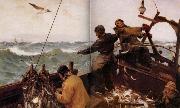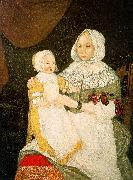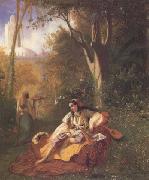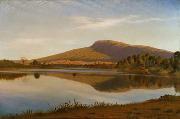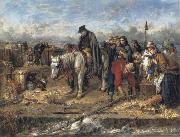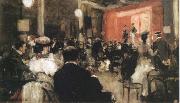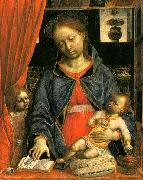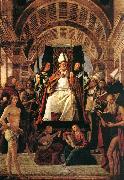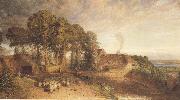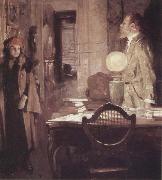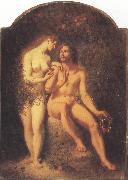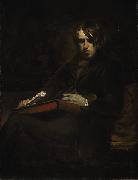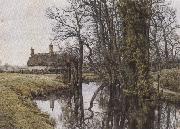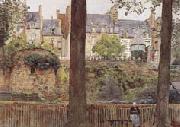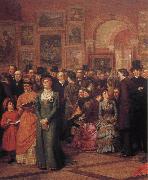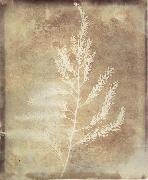|
|
|
|
|
|
|
|
|
|
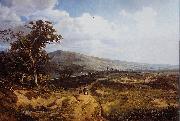 |
Theodore Fourmois
|
|
(14 October 1814 in Presles - October 1871 in Ixelles) was a Belgian landscape painter and printmaker.
Theodore Fourmois learned drawing in the lithographic's workshop of Antoine Dewasme-Pletinckx in Brussels. He first exposed his works in this city in 1836. He began painting landscapes of Ardennes and Campine, several studies and panoramic views while traveling in Dauphine and Switzerland. |
|
|
|
|
|
|
|
|
|
|
|
|
|
|
|
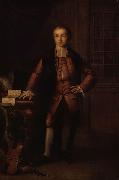 |
Thomas Frye
|
|
The Anglo-Irish painter Thomas Frye (c. 1710 - 3 April 1762 best known for his portraits in oil and pastel, including some miniatures and his early mezzotint engravings, was also the patentee of the Bow porcelain factory, London, and claimed in his epitaph to be "the inventor and first manufacturer of porcelain in England," though his rivals at the Chelsea porcelain factory seem to have preceded him in bringing wares to market. The Bow porcelain works did not long survive Frye's death; their final auctions took place in May 1764.
Thomas Frye was born at Edenderry, County Offaly, Ireland, in 1710; in his youth he went to London to practice as an artist. His earliest work are a pair of pastel portraits of boys, one dated 1734 (Earl of Iveagh). For the Worshipful Company of Saddlers he painted a full-length portrait of Frederick, Prince of Wales (1736, destroyed 1940), which he engraved in mezzotint and published in 1741. With his silent partner, a London merchant Edward Heylyn, he took out a patent on kaolin to be imported from the English colony of Virginia in November 1745, and became manager of the Bow factory from its obscure beginnings in the 1740s. He retired to Wales in 1759 for the sake of his lungs, but soon returned to London and resumed his occupation as an engraver, publishing the series of life-size fancy portraits in mezzotint, by which he is most remembered. He died of consumption on 2 April 1762.
Frye had five children; his two daughters assisted him in painting porcelain at Bow until their marriages. One of them, who married a Mr. Willcox, was employed by Josiah Wedgwood at the Wedgwood Etruria works in painting figure-subjects from 1759 to 1776, the year of her death. |
|
|
|
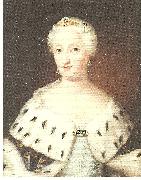 |
ulrica fredrica pasch
|
|
Ulrika Fredrika Pasch, född 10 juli 1735 i Stockholm, död 2 april 1796, var en svensk konstnär. Hon var dotter till konstnären Lorens Pasch d.ä. och Anna Helena Beckamn, syster till konstnären Lorens Pasch d.y. och brorsdotter till konstnären Johan Pasch.
Ulrika Pasch började måla 1756 men hade tidigt tillsammans med sin bror fått undervisning av fadern. Hon blev hushållerska åt en släkting, men målade på fritiden. Under en tioårsperiod försörjde hon sin pappa och syster som professionell porträttmålare i Stockholm innan hennes bror återvände från sina studier utomlands 1766, då de började arbeta tillsammans. Deras samarbete beskrivs som harmoniskt och de valdes båda in i konstakademien 1773. Hon var inte den första kvinnan som valdes in i akademin, men hon var den första kvinnliga yrkeskonstnären som blev vald. Hon ska ha målat detaljerna på broderns tavlor, som klädesdetaljer och liknande. Ulrika hade en framgångsrik karriär och målade ofta porträtt av kungafamiljen och hovet. Hon ansökte dock upprepade gånger förgäves för en pension. Systern Helena Lovisa (1744-96) hushållade åt sina syskon.
Trots att det sägs att hon själv var en ödmjuk person som aldrig framhävde sitt arbete, så är hon en av få kända självförsörjande kvinnliga yrkeskonstnärer i Skandinavien före artonhundratalet. |
|
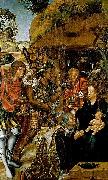 |
Vasco Fernandes
|
|
Vasco Fernandes (c.1475-c.1542), better known as Grão Vasco, was one of the main Portuguese Renaissance painters.
Vasco Fernandes was probably born in Viseu, in Northern Portugal, where he began his career in the team of painters executing the main altarpiece of Viseu Cathedral (1501-1506). Between 1506 and 1511 he painted the main altarpiece of Lamego Cathedral. After working in the Santa Cruz Monastery of Coimbra, Vasco Fernandes returned to Viseu and executed a series of altarpieces for Viseu Cathedral, considered his main works.
Most of his paintings hang nowadays in the Grão Vasco Museum, in Viseu. |
|
|
|
|
|
|
|
|
|
|
|
 |
Wilhelm Ferdinand Bendz
|
|
(March 20, 1804 - November 14, 1832), Danish genre and portrait painter, is one of the main personages associated with the Golden Age of Danish Painting. He was educated at the Royal Danish Academy of Art (Det Kongelige Danske Kunstakademi) in Copenhagen from 1820 to 1825, winning both silver medals but never the gold prize. He studied under professor Christoffer Wilhelm Eckersberg, but may at the same time have acquired some knowledge of contemporary German painting.
Today he is mainly remembered for his many technically accomplished portraits, though his ambition most of all ran towards a refined fusion of portrait, genre scene and allegorical history painting. His technical virtuosity is particularly visible in his depictions of the play of light cast from an obscured source and the resulting shadows. During his travel to Italy - which also brought him a one-year stay in Munich - he caught a sickness to the lungs and died at the age of 28 in 1832. |
|
|
|
|
|
|
|
|
|
|
|
|
|
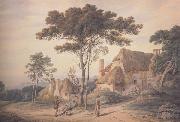 |
William Frederick Wells
|
|
A landscape painter in watercolor, Wells was the true founder of the Society of Painters in Watercolors in 1804 and its president in 1806-07. He studied under J. J. Barralet and exhibited at the Royal Academy from 1795 to 1804 and at the Watercolor Society to 1813, when he resigned.
|
|
|
|
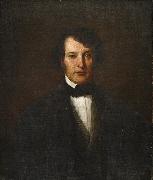 |
William Henry Furness
|
|
(1802-1896) was an American clergyman, theologian, reformer and abolitionist. Following the American Civil War, he raised funds for Black schools in the South, including Morehouse College.
A graduate of the Theological Department of Harvard University, Furness became the Minister of the First Unitarian Church of Philadelphia at the age of 22. A close friend of Ralph Waldo Emerson, Furness presided over a period marked by the growth and increasing prosperity for First Church. A fiery abolitionist, Furness was a supporter of the rights of all segments of society, including African-Americans and Jews. He also lived to see the construction of the current church building in 1885 in the role of Minister Emeritus.
Rev. Furness was the father of painter William Furness, Shakespearean scholar Horace Howard Furness, architect Frank Furness, and author and translator Annis Furness Lee.
|
|
|
|
|
|
|
|
|
|
|
|
|
|









